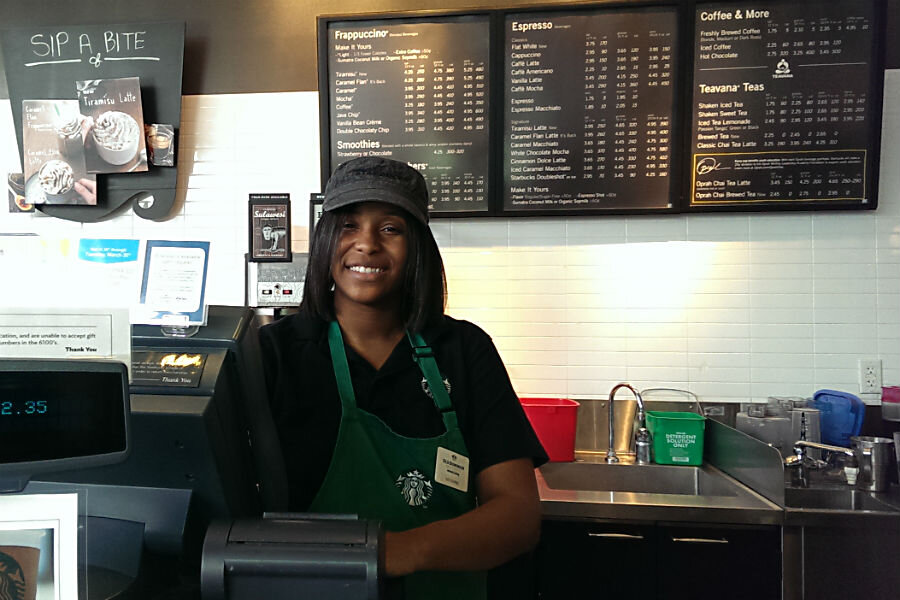Why your Starbucks barista wants to talk about race relations
Loading...
This week Starbucks patrons in line for coffee may find themselves waiting for an impromptu discussion on race relations to take place between barista and fellow patrons as part of the new “Race Together” social awareness campaign initiated by CEO Howard Schultz.
The idea is for a barista to write “Race Together” on a customer’s cup and then engage that customer in a dialogue about race relations in America.
“When did you first become aware of your race?” is one question a barista might ask a patron who is interested in starting one of these free-range “organic dialogues," according to Starbucks’ spokesperson Linda Mills, in a phone interview.
This is not the first Starbucks political or social initiative. In 2011, amid a struggling US economy, the company held a campaign to "Create Jobs for USA Fund," selling red, white and blue woven bracelets with metal clips that read "indivisible." In 2012, during debt ceiling negotiations, Starbucks had its first "Come Together" campaign and for three days baristas in Washington DC wrote “come together” on customers’ cups. During a 2013 political budget crisis, a second "Come Together" campaign was announced, and the company began offering a free tall drink for any customer that bought one for someone else. In September 2013, Shultz wrote an open letter saying that guns were no longer welcome in Starbucks stores or outdoor seating areas.
The latest Starbucks initiative emerged from a series of open forums held over the past three months where more than 2,000 Starbucks employees discussed racial issues in Oakland, Los Angeles, St. Louis, New York and Chicago, according to the company website.
According to Ms. Mills, the participation in the campaign began with those locations last Friday and is slowly rolling out in all 7,000 corporate stores with voluntary participation in the company's 4,000 licensed locations.
“As racially-charged tragedies unfolded in communities across the country, the chairman and ceo [sic] of Starbucks didn’t remain a silent bystander. Howard Schultz voiced his concerns with partners (employees) in the company’s Seattle headquarters and started a discussion about race in America,” the website announced.
CEO Schultz said in a video statement, “If a customer doesn’t want that written on their cup then offer them another beverage. Now, some of you may be uncomfortable doing this, and if you are, you have no mandate from me to do it. Just bow out. You don’t have to do it.”
Thus far the campaign has drawn mixed reviews on Twitter.
In stores, the campaign got off to a halting start Monday, according to managers and employees at 20 Starbucks locations phoned or visited in various states. Both corporate and licensed locations were apparently given a window between Monday and Wednesday this week to complete training and begin engaging patrons in dialogue on race relations.
“The campaign is wonderful,” says marketing consultant Andrew Jensen of New Freedom, Penn., in a phone interview. “But my concern is will it cause slowness and would that slowness be worth it? It may earn them some brownie bucks, but it may push some people away. For me it would be worth it to open the discussion.”
When asked about concerns over slower service, Starbucks spokeswoman Mills says: “Customer experience is a priority for us. Not everyone will feel like participating."
“Starbucks is probably gambling on a small percentage of patrons actually stopping to engage in this conversation,” says Mr. Jensen. “Engaging in social issues is always a gamble in business. Look at Chick-fil-A and its stance on homosexuality. While it can create an extremely fierce audience participation, that in itself can push people away from the brand.”
Supervisor Katherine Bond, who works at a Starbucks outlet on the Old Dominion University campus in Norfolk, Va., had not heard anything about the race relations campaign. But she was enthusiastic about the concept.
“I think it’s good to bring people’s attention and what better way than through Starbucks where so many people come together,” says Ms. Bond in an interview.
Shernae Valentine, a barista at the same location as Bond was hesitant saying, “The concept of ‘Race Together’ is good. Very good. But it’s uncomfortable for some people to discuss. People just come in for their coffee and it could get touchy with some people. I would be nervous about judging who to ask.”
Ms. Valentine and other baristas will largely be on their own for how to reply, but will have a compendium of questions to offer patrons as of Friday.
“We want this to be a thoughtful, organic conversation taking place between the baristas and patrons,” Mills says. “We hope the compendium works from partner [barista] to customer and customer to customer. Those who don’t want to participate don’t have to.”
Mike Dimirsky, owner of Fair Grounds Coffee located across the street from a Starbucks location in Norfolk says in an interview, “Race relations are a very important subject. I applaud anyone’s efforts to start a dialogue.”
Mr. Dimirsky adds, “I myself try to stay out of politics. I could risk losing half my business. I’m no expert on race relations, but people of all races drink coffee.”








